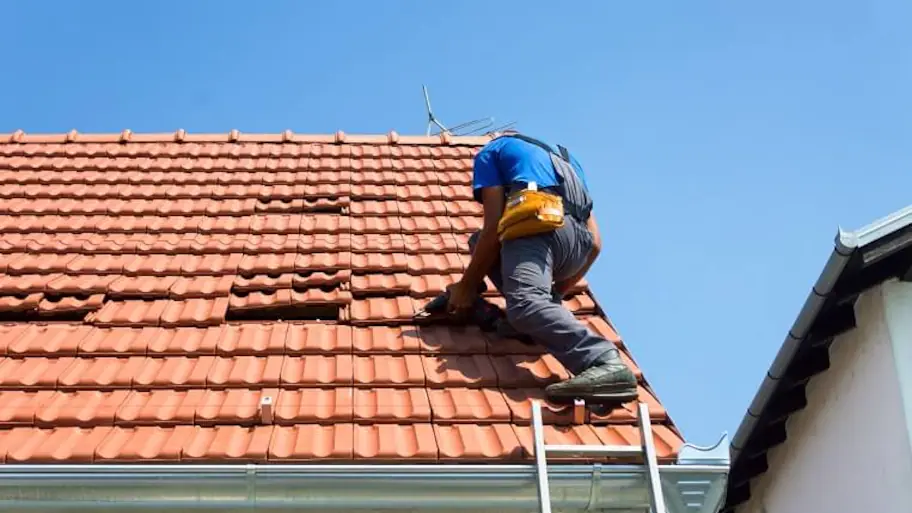
The average cost of roof repair for U.S. homeowners averages between $386 and $1,875. Learn what factors can affect roof repair costs.
Don’t let your roof maintenance fall flat. Avoid costly repairs with these seven tips


Wind, rain, and snow can wreak havoc on a roof, which is why it's essential to perform routine maintenance—like inspections and minor repairs. But if your roof is flat as opposed to pitched, you should do specific preventative tasks to protect it from the elements. Because flat roofs lack a sloping angle, they're prone to catch more leaves, branches, and other debris.
Maintaining your flat roof will cost some money upfront, but will save you a lot in the long run. Here are seven flat-out fantastic flat roof maintenance tips to help avoid pricey repairs.
Every few months, you'll want to check your roof for signs of damage. Flat roofs are relatively easy to walk on, which is a plus for your safety. Look for blisters, loose seams, rusting, fractures, and water pools. If you detect any of these problems, get in touch with a nearby professional roofer to take a look.
Have a professional inspect your roof in the spring and fall. Expect to pay around $200 to $300 for standard professional roof inspection costs. The roof inspector will look for more than what meets the eye to spot any structural damage to your home.
Fixing a water leak makes up nearly half of flat roof repairs. Standing water on flat roofs can cause leaks and water damage in your attic, ceilings, walls, foundation, and more. Call a roofer to repair problems like cracks, blisters, and clogged gutters as soon as possible.
Flat roofs attract far more leaves, twigs, and debris than sloped roofs. Debris accumulation causes water retention and promotes algae and mold growth. Safely get up on your roof every couple of months and remove any debris, especially after stormy weather.
Also, you can have a professional roof cleaner take care of your roof every one to two years to get rid of buildup. Expect to pay $300 to $600 on standard roof cleaning costs.
Trim back overhanging tree branches regularly to help prevent—you guessed it—roof debris. If you think there's a chance of a tree branch collapsing while up there, you may want to call a professional tree trimmer.
Too much weight puts a lot of strain on flat roofs. Ice, snow, and debris are often the culprits. The roof may collapse as a result, causing significant property damage. To ensure your safety, have documentation from a roofing contractor or engineer stating how much weight your flat roof can bear.
Roofing materials can split or crack due to sunlight, temperature changes, stress or strain, or poor craftsmanship. Fill in all cracks and fissures in your roof as you find them.
Flat roofs, like all roofs, are prone to leaks. If you detect a leak, contact a roofing professional to examine the situation and make repairs as needed.
Roof blistering is a term used to describe roof surfaces that appear spongy and soft. They occur when air gets trapped between the layers of felt or the felt substrate. If a blister "pops," water may get inside and cause damage to your roof.
Flat roofs collect more water than sloped roofs, leading to roof erosion, leaks, cracks, and deterioration. But you can lessen the likelihood of these issues by regularly cleaning your gutters and drains, and checking them for blockages.
Once clear, water can flow freely from your roof, slowing down the deterioration of your gutters and drains. You can also have a professional roofer inspect your drainage system and make sure it isn't blocked.
Often, a storm comes barreling in when you least expect it. Being proactive and handling your roof after a hail storm is vital. This inspection should include checking gutters. You'll be able to address any repairs quickly before the damage gets worse and ruins your gutters along with roofing. Checking your roof after high winds will save you money and effort on damages, too.
One of the essential steps you should take is to recoat your flat roof every two to four years. Recoating is vital because flat roofs are comparable to your driveway's material. They may be concrete, asphalt, or felt.
Flat roofs also have varied lifespans depending on the material. When you recoat your roof often, you won't have to spend as much time maintaining it over a long period.
Flat roofs only last, on average, about ten years, while a sloped roof lasts upwards of 15 years. A flat roof replacement costs about $2.50 to $15 per square foot. Though, ensuring regular maintenance on your flat roof will extend its life.
From average costs to expert advice, get all the answers you need to get your job done.

The average cost of roof repair for U.S. homeowners averages between $386 and $1,875. Learn what factors can affect roof repair costs.

Soffit replacement costs depend on multiple factors, like length, accessibility, and material. Learn about the cost factors to budget more accurately.

Metal shake roofs offer a long-lasting alternative to asphalt shingles. Learn what metal shake roofs cost and what factors affect how much you’ll pay.

Roof sheathing is another name for the strong layer of wood boards that are attached to your roof’s framing. Learn how much roof sheathing costs in this guide.

Furring strips support your metal roof and improve ventilation, but only if spaced correctly. Here’s the ideal spacing of furring strips for metal roofs.

Homeowners can fill a gap between their roof and wall with sealant or wire mesh. Here are three steps to help you get the project done safely.